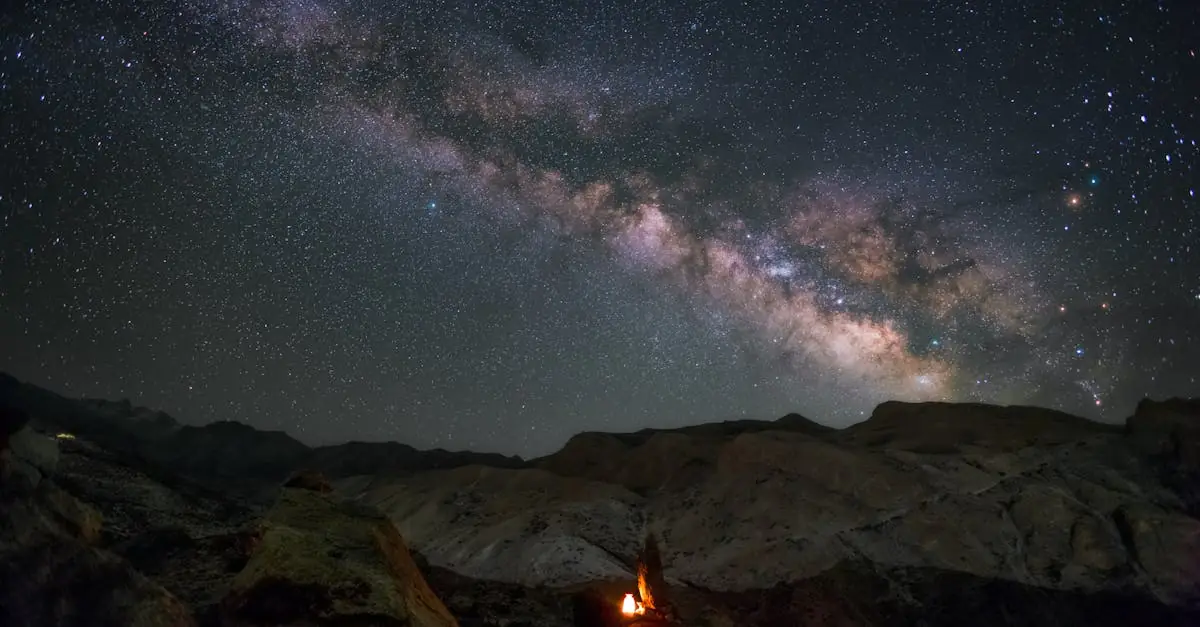Ever wondered what that dazzling light is twinkling in the morning sky? Spoiler alert: it’s not a UFO or your neighbor’s overly ambitious Christmas lights. It’s the Morning Star, also known as Venus, and it’s making headlines as the brightest object after the sun and moon. If you’re on a quest to find this cosmic gem near you, you’re in for a treat.
Imagine sipping your morning coffee while gazing at a celestial wonder. Whether you’re an avid stargazer or just someone who wants to impress friends with some stellar trivia, knowing where to spot the Morning Star can add a sprinkle of magic to your day. So grab your binoculars—or just your favorite mug—and let’s dive into how to catch a glimpse of this heavenly body right from your backyard.
Table of Contents
ToggleWhat Is the Morning Star?
The Morning Star refers to Venus, which shines brightly in the pre-dawn sky. Known for its brilliance, Venus is the second planet from the Sun. This celestial body often appears just before sunrise, captivating those who observe it.
Astronomers categorize Venus as an inferior planet, meaning it orbits closer to the Sun than Earth. Its high reflectivity contributes to its status as the third-brightest object in the sky, following the Sun and Moon. Venus reflects sunlight effectively due to its dense atmosphere filled with clouds of sulfuric acid.
Many cultures throughout history have associated the Morning Star with varying mythologies and meanings. For example, ancient civilizations considered it a signal for dawn, while others regarded it as a symbol of love and beauty.
Spotting the Morning Star can enhance anyone’s morning routine. Observers can typically find Venus in the east before sunrise during specific periods of the year. Understanding its visibility makes it possible for stargazers and casual observers to appreciate its aesthetic appeal.
To locate the Morning Star, viewers should look towards the horizon in the early morning. Checking local sunrise times helps determine the optimal viewing window. Engaging in this simple activity can lead to enriching experiences under the morning sky.
Tracking Venus’s position can also provide insights into the planet’s phases. These phases mimic the Moon’s, changing as Venus orbits the Sun. This phenomenon invites further curiosity and appreciation for our neighboring planet’s dynamic nature.
Benefits of Viewing the Morning Star
Viewing the Morning Star offers various advantages, both culturally and scientifically. Appreciating this celestial marvel enhances one’s connection to the universe.
Cultural Significance
Early civilizations revered Venus for its brightness. The planet often symbolized love and beauty in mythology across different cultures. Ancient Greeks named her Aphrodite while the Romans called her Venus, linking her to similar ideals. Various texts and artworks throughout history showcase this significant connection. Rituals and festivals, celebrating the dawn, further highlight societal reverence for Venus. Observing the Morning Star invites individuals to forge personal connections with these rich cultural narratives.
Scientific Insights
Viewing the Morning Star yields beneficial scientific knowledge. Understanding Venus’s orbit provides insights into planetary behavior as an inferior planet. Researchers study its atmosphere, which reveals important data about climate and potential for hosting life. Tracking the phases of Venus enhances comprehension of celestial mechanics. Regular observation allows for practical astronomy experience, fostering a deeper appreciation for space. Engaging with the Morning Star encourages curiosity about the universe and promotes scientific inquiry.
How to Find the Morning Star Near Me
Finding the Morning Star involves knowing where and when to look. Observers can easily spot Venus by following a few guidelines.
Best Viewing Locations
Open areas away from bright city lights enhance visibility. Parks and nature reserves often provide clear horizons and minimal light pollution. Local hilltops or elevated locations also offer a broader view of the eastern sky. Observers should check community resources for astronomy groups that host star-gazing events, as these gatherings often take place in optimal locations. Familiarity with the surrounding environment helps in tracking Venus’s appearance from various spots.
Tools and Apps for Stargazing
Several mobile apps enhance the stargazing experience. Apps like Star Walk, SkySafari, and Stellarium display real-time planetary positions. They provide alerts when Venus becomes visible, ensuring users won’t miss the Morning Star. Telescopes and binoculars also help in observing details of Venus’s phases. Observers can pair these tools with local astronomy clubs, which may offer insights and equipment for public viewings. Engaging with online astronomy communities supplies additional resources and learning opportunities.
Tips for Stargazing
Engaging in stargazing requires preparation and awareness of environmental factors. Observing the Morning Star becomes an enriching experience with the right approach.
Preparing for Your Adventure
Researching the best times to view Venus enhances the chances of a successful observation. Knowing local sunrise times helps coordinate adventures around optimum visibility. Gathering essential gear like blankets or chairs makes the experience comfortable. Using smartphones to access stargazing apps offers real-time data on planetary positions. Choosing a suitable location away from city lights significantly improves visibility. Connecting with local astronomy clubs may provide useful insights and resources for a fulfilling experience.
Optimal Weather Conditions
Clear skies play a crucial role in successful stargazing. Checking the weather forecast ensures observers select nights with minimal cloud cover. While cool, dry nights often yield the best visibility, full moons may wash out fainter stars. Assessing light pollution levels in chosen locations can significantly affect the viewing experience. Calm conditions prevent atmospheric disturbances that obscure clarity, especially when observing planets. Frequent checks on real-time satellite images help gauge cloud cover and overall visibility before heading out.
Observing the Morning Star offers a unique opportunity to connect with the wonders of the universe. Whether it’s enhancing a morning routine or diving into the rich cultural narratives surrounding Venus, the experience can be both enlightening and enjoyable.
Taking the time to prepare and choose the right location can significantly improve visibility. Engaging with local astronomy communities can further enrich this stargazing journey. By embracing the beauty of the Morning Star, individuals can foster a deeper appreciation for the cosmos and inspire curiosity about the celestial world.




